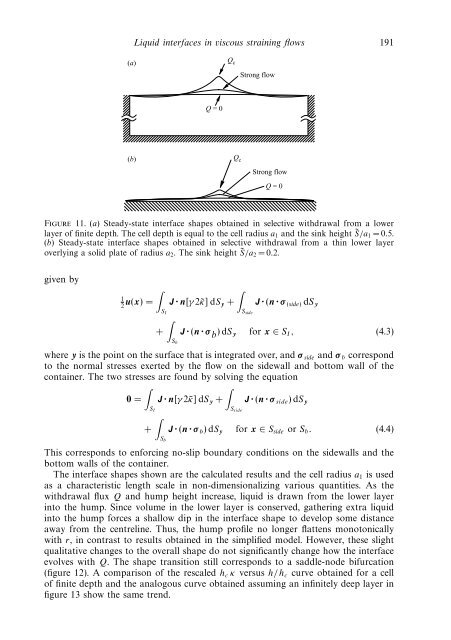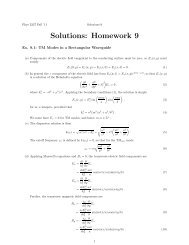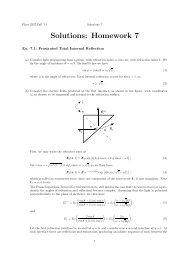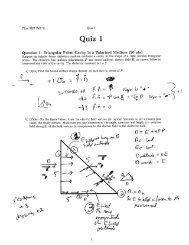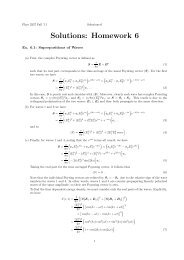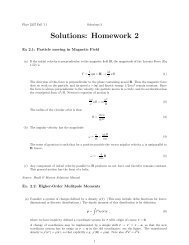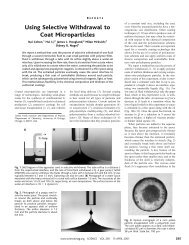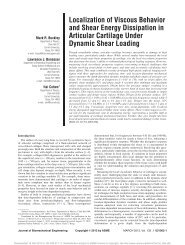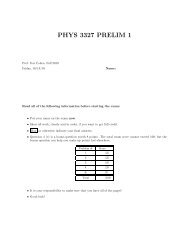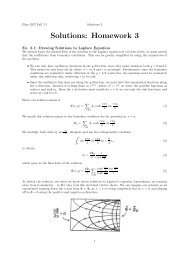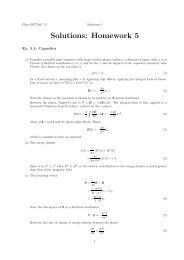Liquid interfaces in viscous straining flows ... - Itai Cohen Group
Liquid interfaces in viscous straining flows ... - Itai Cohen Group
Liquid interfaces in viscous straining flows ... - Itai Cohen Group
Create successful ePaper yourself
Turn your PDF publications into a flip-book with our unique Google optimized e-Paper software.
<strong>Liquid</strong> <strong><strong>in</strong>terfaces</strong> <strong>in</strong> <strong>viscous</strong> stra<strong>in</strong><strong>in</strong>g <strong>flows</strong> 191(a)Q cStrong flowQ = 0(b)Q cStrong flowQ = 0Figure 11. (a) Steady-state <strong>in</strong>terface shapes obta<strong>in</strong>ed <strong>in</strong> selective withdrawal from a lowerlayer of f<strong>in</strong>ite depth. The cell depth is equal to the cell radius a 1 and the s<strong>in</strong>k height ˜S/a 1 =0.5.(b) Steady-state <strong>in</strong>terface shapes obta<strong>in</strong>ed <strong>in</strong> selective withdrawal from a th<strong>in</strong> lower layeroverly<strong>in</strong>g a solid plate of radius a 2 . The s<strong>in</strong>k height ˜S/a 2 =0.2.given by∫1u(x) = J · n[γ 2˜κ]dS2 y + J · (n · σ (side) dS y∫S I S side∫+ J · (n · σ b )dS y for x ∈ S I , (4.3)S bwhere y is the po<strong>in</strong>t on the surface that is <strong>in</strong>tegrated over, and σ side and σ b correspondto the normal stresses exerted by the flow on the sidewall and bottom wall of theconta<strong>in</strong>er. The two stresses are found by solv<strong>in</strong>g the equation∫∫0 = J · n[γ 2˜κ]dS y + J · (n · σ side )dS yS I S side∫+ J · (n · σ b )dS y for x ∈ S side or S b . (4.4)S bThis corresponds to enforc<strong>in</strong>g no-slip boundary conditions on the sidewalls and thebottom walls of the conta<strong>in</strong>er.The <strong>in</strong>terface shapes shown are the calculated results and the cell radius a 1 is usedas a characteristic length scale <strong>in</strong> non-dimensionaliz<strong>in</strong>g various quantities. As thewithdrawal flux Q and hump height <strong>in</strong>crease, liquid is drawn from the lower layer<strong>in</strong>to the hump. S<strong>in</strong>ce volume <strong>in</strong> the lower layer is conserved, gather<strong>in</strong>g extra liquid<strong>in</strong>to the hump forces a shallow dip <strong>in</strong> the <strong>in</strong>terface shape to develop some distanceaway from the centrel<strong>in</strong>e. Thus, the hump profile no longer flattens monotonicallywith r, <strong>in</strong> contrast to results obta<strong>in</strong>ed <strong>in</strong> the simplified model. However, these slightqualitative changes to the overall shape do not significantly change how the <strong>in</strong>terfaceevolves with Q. The shape transition still corresponds to a saddle-node bifurcation(figure 12). A comparison of the rescaled h c κ versus h/h c curve obta<strong>in</strong>ed for a cellof f<strong>in</strong>ite depth and the analogous curve obta<strong>in</strong>ed assum<strong>in</strong>g an <strong>in</strong>f<strong>in</strong>itely deep layer <strong>in</strong>figure 13 show the same trend.


